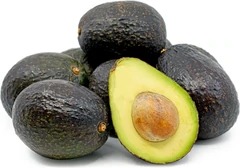10 Summer Fruits & Vegetables in Season Right Now
1. Avocados
Magically, avocados are available year-round, with California’s Hass avocados at their peak in the summer months! Hass has some other big advantages over other types. The trees grow vigorously, are easy to propagate, and produce an impressive amount of fruit by only the second or third year. They also have a longer harvest season. Hass avocados are touted for their high quantity of good fat (or oleic, monounsaturated, and therefore heart-healthy fat), and avocados in general are also an excellent source of potassium, folate, vitamins C and B6, thiamin, riboflavin, niacin, and magnesium. In addition, avocados also contain a compound that helps with the absorption of healthy carotenoids from vegetables, making them a welcome addition to a seasonal chopped salad (or when combined with store-bought salsa, for a quick guacamole)
2. Blueberries
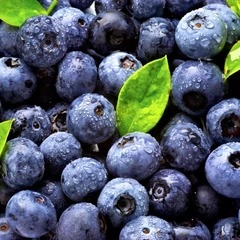 Like avocados, we often enjoy blueberries year round. Blueberries are just too darn delicious to pass up for the summer season. Relatively low in calories and carbohydrates, blueberries boast a ridiculously high level of antioxidants that protect against free-radical activity that can cause cataracts, glaucoma, varicose veins, hemorrhoids, peptic ulcers, heart disease, and cancer. In addition, blueberries also boast a high level of vitamin C, manganese, and dietary fiber. When selecting blueberries, look for those that are firm, deeply hued, and are stored in containers that allow them to move freely and do not appear moist (both of which can lead to premature molding). Store in a cold, dry place and wash only when ready to serve as moisture can damage the berries or hasten the degeneration process. Blueberries can be eaten alone, added to breakfast smoothies or protein shakes, sprinkled on top of a salad, or served as a dessert with fresh cream.
Like avocados, we often enjoy blueberries year round. Blueberries are just too darn delicious to pass up for the summer season. Relatively low in calories and carbohydrates, blueberries boast a ridiculously high level of antioxidants that protect against free-radical activity that can cause cataracts, glaucoma, varicose veins, hemorrhoids, peptic ulcers, heart disease, and cancer. In addition, blueberries also boast a high level of vitamin C, manganese, and dietary fiber. When selecting blueberries, look for those that are firm, deeply hued, and are stored in containers that allow them to move freely and do not appear moist (both of which can lead to premature molding). Store in a cold, dry place and wash only when ready to serve as moisture can damage the berries or hasten the degeneration process. Blueberries can be eaten alone, added to breakfast smoothies or protein shakes, sprinkled on top of a salad, or served as a dessert with fresh cream.
3. Cucumbers
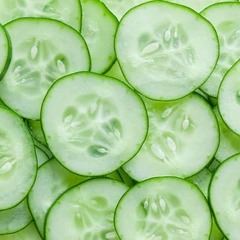 Nothing is more refreshing than a cool summer cucumber. Make a tomato-cucumber salad, a smoothy, or add it to a gin and tonic. A member of the squash family, cucumber’s high water content makes it a refreshing (and hydrating) addition to summer menus. Although comprised primarily of water, cucumber is also a good source of vitamin C and silica, which is important for connective tissue health and also does wonders for the skin (both when ingested or applied topically to reduce swelling or redness). In addition, the skin of the cucumber is a great source of fiber, potassium, and magnesium. When selecting a cucumber, look for slender cucumbers (which are a sign of their tender age) and those with dark green, firm skins. Cucumbers can be added raw to salads, sandwiches, soups, or dips, and are most flavorful when paired with chives, dill, and mint.
Nothing is more refreshing than a cool summer cucumber. Make a tomato-cucumber salad, a smoothy, or add it to a gin and tonic. A member of the squash family, cucumber’s high water content makes it a refreshing (and hydrating) addition to summer menus. Although comprised primarily of water, cucumber is also a good source of vitamin C and silica, which is important for connective tissue health and also does wonders for the skin (both when ingested or applied topically to reduce swelling or redness). In addition, the skin of the cucumber is a great source of fiber, potassium, and magnesium. When selecting a cucumber, look for slender cucumbers (which are a sign of their tender age) and those with dark green, firm skins. Cucumbers can be added raw to salads, sandwiches, soups, or dips, and are most flavorful when paired with chives, dill, and mint.
4. Eggplant
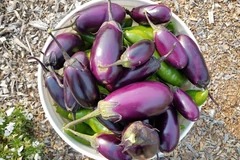 Although it's almost always assumed that eggplants have purple skin, they can come in just about any shade from black to a near-translucent white (and just about every color in between!) Eggplants are revered for their excellent fiber content as well as several phytonutrients that play an important role in antioxidant activity. Although selecting an eggplant is easy enough – again, just look for those with smooth, taut skin, and those that feel heavy for their size – cooking can be a little bit more complicated. If the eggplant is young, the skin is edible, but if it’s a little bit older, the skin will taste bitter and is best removed. If this is the case, cut or slice the eggplant, salt it and set it out to “weep” for 20 minutes, a process that will remove any residual bitterness. Eggplant is tasty grilled and seasoned with oregano, salt and pepper, or as a casserole when combined with tomatoes, olives, peppers, onions, and fresh oregano.
Although it's almost always assumed that eggplants have purple skin, they can come in just about any shade from black to a near-translucent white (and just about every color in between!) Eggplants are revered for their excellent fiber content as well as several phytonutrients that play an important role in antioxidant activity. Although selecting an eggplant is easy enough – again, just look for those with smooth, taut skin, and those that feel heavy for their size – cooking can be a little bit more complicated. If the eggplant is young, the skin is edible, but if it’s a little bit older, the skin will taste bitter and is best removed. If this is the case, cut or slice the eggplant, salt it and set it out to “weep” for 20 minutes, a process that will remove any residual bitterness. Eggplant is tasty grilled and seasoned with oregano, salt and pepper, or as a casserole when combined with tomatoes, olives, peppers, onions, and fresh oregano.
5. Peppers
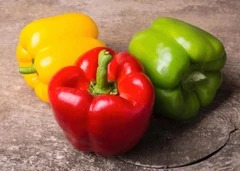 Peppers have made Oprah’s list of top superfoods! Chief among its benefits, hot peppers boast a hefty dose of capsaicin, a compound that can alleviate the symptoms of migraine headaches, arthritis, inflammation, gastric ailments (really!), reduce the risk of cancer, and serve as a thermogenic agent to speed metabolic activity. In addition, peppers are high in antioxidant carotenes and flavonoids, and contain about twice the amount of vitamin C as oranges. Due to the intense flavor of peppers, they are best used to spice up everyday soups, stews, chili dishes, stir-fries, salads, and salsas.
Peppers have made Oprah’s list of top superfoods! Chief among its benefits, hot peppers boast a hefty dose of capsaicin, a compound that can alleviate the symptoms of migraine headaches, arthritis, inflammation, gastric ailments (really!), reduce the risk of cancer, and serve as a thermogenic agent to speed metabolic activity. In addition, peppers are high in antioxidant carotenes and flavonoids, and contain about twice the amount of vitamin C as oranges. Due to the intense flavor of peppers, they are best used to spice up everyday soups, stews, chili dishes, stir-fries, salads, and salsas. 7. Cherries
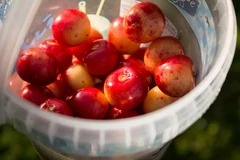 Summer is always a favorite in the produce aisle thanks to the abundance of fresh and in-season fruits and veggies. Cherry season is on now, and it may be short, but it's oh so sweet! When our field inspectors scout out cherries for us, they’re looking for fresh green stems and firm, juicy fruit. Add them to salads, desserts, and salsas.
Summer is always a favorite in the produce aisle thanks to the abundance of fresh and in-season fruits and veggies. Cherry season is on now, and it may be short, but it's oh so sweet! When our field inspectors scout out cherries for us, they’re looking for fresh green stems and firm, juicy fruit. Add them to salads, desserts, and salsas. Cherries are one of the few natural sources of melatonin, a hormone produced by the pineal gland in the brain that helps regulate the body’s internal clock.
8. Corn
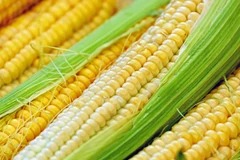 Long, warm days and light summer meals make fresh corn a summer must. Generally at its sweetest when it’s eaten as close to harvest as possible. If you have local corn available, summer’s a great time to enjoy what local farmers have harvested; fresh, local corn is sweetest (and bicolor - white and yellow are equally good, the color isn’t an indicator)
Long, warm days and light summer meals make fresh corn a summer must. Generally at its sweetest when it’s eaten as close to harvest as possible. If you have local corn available, summer’s a great time to enjoy what local farmers have harvested; fresh, local corn is sweetest (and bicolor - white and yellow are equally good, the color isn’t an indicator)
9. Shallots
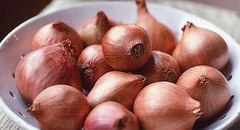 Of all the vegetables in the onion and leek family, shallots have one of the highest concentrations of antioxidants. In addition, they have also shown to have anti-bacterial, anti-inflammatory, and anti-allergic properties. As such, shallots are associated with a reduction in risk for several cancers, including those affecting the liver and colon, as well as heart disease and diabetes. If you’re thinking of trading in your regular white onion for a shallot, choose those that are firm and appear dry. When cooking, separate similar to a garlic clove and use as a base for sauces or to add taste and texture to casseroles, stir-fries or other dishes where onions are common.
Of all the vegetables in the onion and leek family, shallots have one of the highest concentrations of antioxidants. In addition, they have also shown to have anti-bacterial, anti-inflammatory, and anti-allergic properties. As such, shallots are associated with a reduction in risk for several cancers, including those affecting the liver and colon, as well as heart disease and diabetes. If you’re thinking of trading in your regular white onion for a shallot, choose those that are firm and appear dry. When cooking, separate similar to a garlic clove and use as a base for sauces or to add taste and texture to casseroles, stir-fries or other dishes where onions are common.
One of the most undervalued yet immensely valuable vegetables in our markets is the shallot. And while it is available year round, it has a fresh harvest season.
Why not just use onions? Because shallots have a unique flavor that’s different from onions, leeks, and garlic. It’s more delicate, with a lovely tenderness that allows them to soften quickly and easily during cooking. The glassy membranes between the thin growth rings are just a film, not nearly as tough as onions.
By the way, the words shallot and scallion are cognate, derived from the same root: the Greek word Askolonion, a name for bunching onions that dates back to 300 BCE.
10. Zucchini
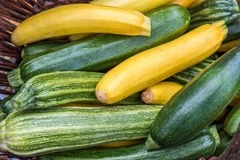 Freshest – and most plentiful – among local growers between May and July, zucchinis are an excellent source of vitamin C and manganese, and a good source of dietary fiber, magnesium, vitamin A, potassium, copper, folate, phosphorus, omega-3 fatty acids, protein, and several B vitamins. When shopping for zucchini, look for those that resemble a cucumber in size and shape and have a smooth, thin skin that is either green or yellow in color. To enjoy, cut in half, drizzle with oil, salt and pepper and bake at 350 degrees for 20-25 minutes. If you’d prefer your zucchini raw consider chopping julienne and serving as part of a vegetable platter or add grated to salads, sandwiches, and other summer salads.
Freshest – and most plentiful – among local growers between May and July, zucchinis are an excellent source of vitamin C and manganese, and a good source of dietary fiber, magnesium, vitamin A, potassium, copper, folate, phosphorus, omega-3 fatty acids, protein, and several B vitamins. When shopping for zucchini, look for those that resemble a cucumber in size and shape and have a smooth, thin skin that is either green or yellow in color. To enjoy, cut in half, drizzle with oil, salt and pepper and bake at 350 degrees for 20-25 minutes. If you’d prefer your zucchini raw consider chopping julienne and serving as part of a vegetable platter or add grated to salads, sandwiches, and other summer salads.
Our top summer produce picks will change from one summer to the next. In fact, ask us what our top 10 veggie recommendations are next week and we are likely to serve up a different list entirely. There are so many delicious veggie options it is difficult to be too partial to any item for too long.
